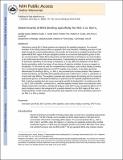Determinants of BH3 Binding Specificity for Mcl-1 versus BcI-x[subscript L]
Author(s)
Dutta, Sanjib; Gulla, Stefano; Fire, Emiko; Keating, Amy E.; Chen, T. Scott; Grant, Robert A; ... Show more Show less
DownloadKeating_Determinants of.pdf (2.247Mb)
OPEN_ACCESS_POLICY
Open Access Policy
Creative Commons Attribution-Noncommercial-Share Alike
Terms of use
Metadata
Show full item recordAbstract
Interactions among Bcl-2 family proteins are important for regulating apoptosis. Prosurvival members of the family interact with proapoptotic BH3 (Bcl-2-homology-3)-only members, inhibiting execution of cell death through the mitochondrial pathway. Structurally, this interaction is mediated by binding of the α-helical BH3 region of the proapoptotic proteins to a conserved hydrophobic groove on the prosurvival proteins. Native BH3-only proteins exhibit selectivity in binding prosurvival members, as do small molecules that block these interactions. Understanding the sequence and structural basis of interaction specificity in this family is important, as it may allow the prediction of new Bcl-2 family associations and/or the design of new classes of selective inhibitors to serve as reagents or therapeutics. In this work, we used two complementary techniques—yeast surface display screening from combinatorial peptide libraries and SPOT peptide array analysis—to elucidate specificity determinants for binding to Bcl-x[subscript L]versus Mcl-1, two prominent prosurvival proteins. We screened a randomized library and identified BH3 peptides that bound to either Mcl-1 or Bcl-x[subscript L] selectively or to both with high affinity. The peptides competed with native ligands for binding into the conserved hydrophobic groove, as illustrated in detail by a crystal structure of a specific peptide bound to Mcl-1. Mcl-1-selective peptides from the screen were highly specific for binding Mcl-1 in preference to Bcl-x[subscript L], Bcl-2, Bcl-w, and Bfl-1, whereas Bcl-x[subscript L]-selective peptides showed some cross-interaction with related proteins Bcl-2 and Bcl-w. Mutational analyses using SPOT arrays revealed the effects of 170 point mutations made in the background of a peptide derived from the BH3 region of Bim, and a simple predictive model constructed using these data explained much of the specificity observed in our Mcl-1 versus Bcl-x[subscript L] binders.
Date issued
2010-04Department
Massachusetts Institute of Technology. Department of BiologyJournal
Journal of Molecular Biology
Publisher
Elsevier
Citation
Dutta, Sanjib et al. “Determinants of BH3 Binding Specificity for Mcl-1 Versus Bcl-x[subscript L].” Journal of Molecular Biology 398.5 (2010): 747–762.
Version: Author's final manuscript
ISSN
0022-2836
1089-8638